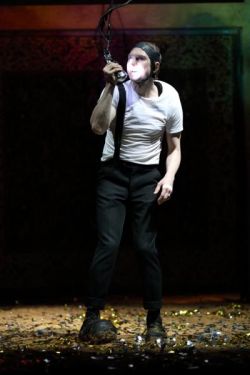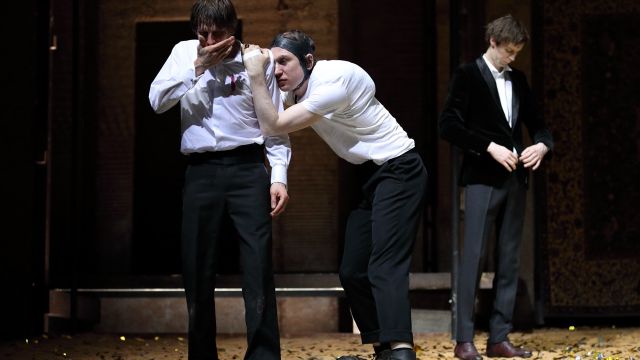Richard III
Shakespeare’s Richard III has been one of his most popular works ever since it was first performed in 1594. It has an extremely long and varied performance history of productions around the world, including Germany. There is evidence of Shakespeare’s plays being performed in Germany from the early 1600s and Thomas Ostermeier and Berlin’s Schaubühne Theatre Company have been leaders in contemporary theatre for many years.
This work of Richard III, especially of classical texts, is respectful and at the same time challenging, provocative and highly entertaining on all levels. The production is absolutely terrific – but be warned – it is also challenging. There is full frontal nudity and more importantly, there is no interval.
It is not the full text, which rivals Hamlet in its length, and some of the characters are cut out, such as Richard’s mother, the Duchess of York. Nonetheless, it is otherwise a very clear, vibrant and thrilling ‘modern’ production.
As with any production of Richard III a large measure of responsibility rests with the actor playing Richard. This is a tour de force role that demands a tour de force actor.
Lars Eidinger is fantastic as Richard.

The character demands, at least for most of the play, having a jovial and friendly relationship with the audience. In the original text, no one other than Queen Margaret directly addresses the audience. Even at his most ghastly, such as plotting the deaths of his two young nephews, Richard is funny. The humour is essential, as in a way it makes the audience complicit in Richard’s murderous actions and rise to power. The direct address, however, stops when he becomes King and he withdraws, not only from his co-conspirators on-stage (whom he has murdered) but also the audience.
Having recently watched Benedict Cumberbatch’s BBC film version I was intrigued to see if this Richard had any differences and similarities in regard to a modern interpretation of the character. There is some, but not much. This German Richard is far less sentimental and neurotic than Cumberbatch’s. One similarity, however, was in the setting for the famous ‘wooing’ scene between Richard and Lady Anne. In both these recent versions the scene is given a private setting with no one else present. This is not the original setting for this scene, which is very public, with other characters on-stage. It is truly an extraordinary scene; nothing else quite like it had appeared on the English stage prior to this.
Each actor will interpret the scene differently, and the central question or challenge is why does Lady Anne acquiesce to Richard’s ‘wooing’? In this case it wasn’t so much him stripping bare and holding the sword to his chest, rather it was the crying after Lady Anne spat at him. The crying, of course, was completely fake, but the Lady Anne was completely taken in.
This is just a small example of this wonderful and insightful production. Highly recommended.
Tony Knight
Photographer: Tony Lewis
Subscribe to our E-Newsletter, buy our latest print edition or find a Performing Arts book at Book Nook.

